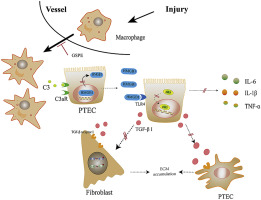当前位置:
X-MOL 学术
›
Chem. Biol. Interact.
›
论文详情
Our official English website, www.x-mol.net, welcomes your feedback! (Note: you will need to create a separate account there.)
GSPE alleviates renal fibrosis by inhibiting the activation of C3/ HMGB1/ TGF-β1 pathway.
Chemico-Biological Interactions ( IF 5.1 ) Pub Date : 2019-12-23 , DOI: 10.1016/j.cbi.2019.108926 Kun Wang 1 , Haotian Wei 1 , Juan Zhan 1 , Xinjun Liang 2 , Chunxiu Zhang 1 , Yanyan Liu 1 , Gang Xu 1
Chemico-Biological Interactions ( IF 5.1 ) Pub Date : 2019-12-23 , DOI: 10.1016/j.cbi.2019.108926 Kun Wang 1 , Haotian Wei 1 , Juan Zhan 1 , Xinjun Liang 2 , Chunxiu Zhang 1 , Yanyan Liu 1 , Gang Xu 1
Affiliation

|
Grape seed proanthocyanidin extract (GSPE) has been reported to exhibit a variety of protective effects, such as antioxidant, anti-atherosclerosis and other pharmacological effects. As a member of the complement system, complement component 3 (C3) deposition in the glomerulus is recognized as an important causative mediator of various kidney diseases. In this study, we aimed to identify the effect of GSPE on C3 in the chronic kidney fibrosis and evaluate the possible mechanism. We observed that administration of GSPE relieves inflammation and chronic renal fibrosis in mouse models of UUO. GSPE inhibited C3 secreted by macrophages to relieve renal interstitial inflammation. In vitro, we found that C3 stimulated HMGB1 translocation form nucleus to cytoplasm and promote the expression of pro-inflammatory cytokines including TGF-β1 in primary renal tubular epithelial cells (PTEC), which could be inhibited by GSPE. Meanwhile, GSPE could also decreased HMGB1-induced EMT of PTEC through suppresses the HMGB1/TLR4/p65/TGF-β1 pathway. In addition, the myofibroblast activation was inhibited by GSPE via TGF-β1/Smad2/3 signaling pathways in normal rat kidney fibroblast (NRK-49F) cells. Overall, these observations provide that GSPE alleviates renal fibrosis by inhibiting the C3/HMGB1/TGF-β1 pathway and could thus lead to find the potential therapy for the suppression of renal fibrosis.
中文翻译:

GSPE通过抑制C3 / HMGB1 /TGF-β1途径的活化来减轻肾脏纤维化。
据报道,葡萄籽原花青素提取物(GSPE)具有多种保护作用,例如抗氧化剂,抗动脉粥样硬化和其他药理作用。作为补体系统的成员,肾小球中的补体成分3(C3)沉积被认为是各种肾脏疾病的重要病因。在这项研究中,我们旨在确定GSPE对慢性肾脏纤维化中C3的作用并评估可能的机制。我们观察到,GSPE的给药可减轻UUO小鼠模型的炎症和慢性肾纤维化。GSPE抑制巨噬细胞分泌的C3以减轻肾间质炎症。体外,我们发现C3刺激HMGB1易位,从核到细胞质,并促进原发性肾小管上皮细胞(PTEC)中促炎性细胞因子(包括TGF-β1)的表达,而GSPE可能抑制了这种表达。同时,GSPE还可以通过抑制HMGB1 / TLR4 / p65 /TGF-β1途径来降低HMGB1诱导的PTEC的EMT。此外,在正常大鼠肾成纤维细胞(NRK-49F)中,GSPE通过TGF-β1/ Smad2 / 3信号通路抑制了肌成纤维细胞的活化。总体而言,这些观察结果提供了GSPE通过抑制C3 / HMGB1 /TGF-β1途径来减轻肾纤维化,从而可能找到抑制肾纤维化的潜在疗法。GSPE还可以通过抑制HMGB1 / TLR4 / p65 /TGF-β1途径来降低HMGB1诱导的PTEC的EMT。此外,在正常大鼠肾成纤维细胞(NRK-49F)中,GSPE通过TGF-β1/ Smad2 / 3信号通路抑制了肌成纤维细胞的活化。总体而言,这些观察结果提供了GSPE通过抑制C3 / HMGB1 /TGF-β1途径来减轻肾纤维化,从而可能找到抑制肾纤维化的潜在疗法。GSPE还可以通过抑制HMGB1 / TLR4 / p65 /TGF-β1途径来降低HMGB1诱导的PTEC的EMT。此外,在正常大鼠肾成纤维细胞(NRK-49F)中,GSPE通过TGF-β1/ Smad2 / 3信号通路抑制了肌成纤维细胞的活化。总体而言,这些观察结果提供了GSPE通过抑制C3 / HMGB1 /TGF-β1途径来减轻肾纤维化,从而可能找到抑制肾纤维化的潜在疗法。
更新日期:2019-12-23
中文翻译:

GSPE通过抑制C3 / HMGB1 /TGF-β1途径的活化来减轻肾脏纤维化。
据报道,葡萄籽原花青素提取物(GSPE)具有多种保护作用,例如抗氧化剂,抗动脉粥样硬化和其他药理作用。作为补体系统的成员,肾小球中的补体成分3(C3)沉积被认为是各种肾脏疾病的重要病因。在这项研究中,我们旨在确定GSPE对慢性肾脏纤维化中C3的作用并评估可能的机制。我们观察到,GSPE的给药可减轻UUO小鼠模型的炎症和慢性肾纤维化。GSPE抑制巨噬细胞分泌的C3以减轻肾间质炎症。体外,我们发现C3刺激HMGB1易位,从核到细胞质,并促进原发性肾小管上皮细胞(PTEC)中促炎性细胞因子(包括TGF-β1)的表达,而GSPE可能抑制了这种表达。同时,GSPE还可以通过抑制HMGB1 / TLR4 / p65 /TGF-β1途径来降低HMGB1诱导的PTEC的EMT。此外,在正常大鼠肾成纤维细胞(NRK-49F)中,GSPE通过TGF-β1/ Smad2 / 3信号通路抑制了肌成纤维细胞的活化。总体而言,这些观察结果提供了GSPE通过抑制C3 / HMGB1 /TGF-β1途径来减轻肾纤维化,从而可能找到抑制肾纤维化的潜在疗法。GSPE还可以通过抑制HMGB1 / TLR4 / p65 /TGF-β1途径来降低HMGB1诱导的PTEC的EMT。此外,在正常大鼠肾成纤维细胞(NRK-49F)中,GSPE通过TGF-β1/ Smad2 / 3信号通路抑制了肌成纤维细胞的活化。总体而言,这些观察结果提供了GSPE通过抑制C3 / HMGB1 /TGF-β1途径来减轻肾纤维化,从而可能找到抑制肾纤维化的潜在疗法。GSPE还可以通过抑制HMGB1 / TLR4 / p65 /TGF-β1途径来降低HMGB1诱导的PTEC的EMT。此外,在正常大鼠肾成纤维细胞(NRK-49F)中,GSPE通过TGF-β1/ Smad2 / 3信号通路抑制了肌成纤维细胞的活化。总体而言,这些观察结果提供了GSPE通过抑制C3 / HMGB1 /TGF-β1途径来减轻肾纤维化,从而可能找到抑制肾纤维化的潜在疗法。


























 京公网安备 11010802027423号
京公网安备 11010802027423号